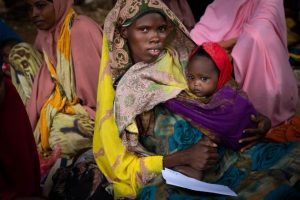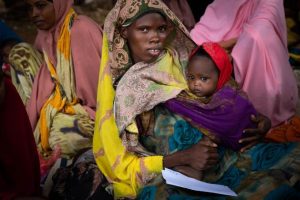Food Beyond the Reach for Millions in Horn of Africa
 28 Juni 2023
28 Juni 2023

Ayan (25) with her daughter Mushtaq (15 months) in the waiting area of the WFP funded Kabasa MAM Health Center. Credit: WFP/Samantha Reinders.
By Paul Virgo
ROME, Jun 28 2023 (IPS)
Four months pregnant, Ayan was close to dying of starvation when she arrived at the Kabasa camp in Dolow, on the border between Somalia and Ethiopia.
Her 18-month-old daughter, Mushtaq, was so severely malnourished that she weighed just 6.7 kilos.
Drought had forced the family to flee their home in Somalia.
Three years of drought have left more than 23 million people across parts of Ethiopia, Kenya and Somalia facing severe hunger, the WFP says. When the region’s long-awaited rains finally arrived in March, instead of bringing relief, the downpours were so extreme they caused flash floods that inundated homes and farmland and washed away livestock
Ayan’s husband died shortly after their arrival.
“We came here as we heard we would get some help,” Ayan said at a health centre funded by the United Nations World Food Programme (WFP).
“We left our home because there was no water and our livestock had died.”
Thanks to nutritional therapy and fortified cereals provided by the WFP, Ayan and Mushtaq are still alive.
Many others do not make it.
Three years of drought have left more than 23 million people across parts of Ethiopia, Kenya and Somalia facing severe hunger, the WFP says.
When the region’s long-awaited rains finally arrived in March, instead of bringing relief, the downpours were so extreme they caused flash floods that inundated homes and farmland and washed away livestock.
Consecutive failed harvests and high transport costs have pushed food prices far beyond the reach of millions in the region, the WFP says, with a food basket in Eastern Africa costing 40% more in March 2023 than it did 12 months previously
The limited humanitarian resources are being further stretched by the conflict in Sudan, which has sent over 250,000 people fleeing into neighbouring countries such as Ethiopia and South Sudan, where food insecurity is already desperately high.
“Conflict and drought are devastating millions of Somalis. Children are paying the highest price of all,” said WFP Executive Director Cindy McCain during a visit to Somalia in May. “Nearly 500,000 children are at risk of dying”.
The Horn of Africa is on the front line of the climate crisis.
A study released in April by World Weather Attribution (WWA) said that the drought in the Horn of Africa would probably not have happened without human-caused climate change.
“Climate change has made events like the current drought much stronger and more likely,” WWA said.
“A conservative estimate is that such droughts have become about 100 times more likely”.
The tragedy is also a massive injustice as poor countries like these are responsible for only a tiny part of the global emissions that have caused the climate crisis.
But they are feeling its effects most severely.
The UN Food and Agriculture Organization (FAO) has said the region is facing an “unprecedented disaster”.
“Many farming households have experienced several consecutive poor harvests and up to 100% losses, especially in the arid and semi-arid areas,” said Cyril Ferrand, the FAO’s Resilience Team Leader for East Africa.
“Some agropastoral communities lost all sources of food and income.
“In addition, 2.3 million people have been displaced across the region in search of basic services, water and food.
“And we know very well that when people are on the move, it is also an issue of security, violence, and gender-based violence, in particular.
“In short, the drought triggered a livelihood crisis that has grown into a multifaceted humanitarian disaster including displacement, health issues, malnutrition and security crisis that has long-term effects on people’s lives and livelihoods”
Ferrand said that pastoralists across the region lost over 13 million livestock between late 2020 and the end of 2022 due to lack of water and feed.
This is important because livestock are not only the main source of income for pastoralist households, but they are also a source of milk, which is vital for healthy diets, especially for children under five.
The loss of animals and the related deficit in milk production, therefore, is a big factor in the region’s high rate of malnutrition.
The WFP, meanwhile, says that it urgently needs US 810 million dollars over the next six months to fill a funding shortfall in order to keep life-saving assistance going and invest in long-term resilience in the Horn of Africa.
The UN agency was distributing food assistance to a record 4.7 million people a month in Somalia at the end of 2022.
But it was forced to reduce this to three million people in April and may have to further reduce the emergency food assistance caseload in Somalia to just 1.8 million by July.
This means almost three million people in need will not receive support.
“WFP’s rapid expansion of life-saving assistance helped prevent famine in Somalia in 2022,” said Michael Dunford, the WFP Regional Director for Eastern Africa.
“But despite the emergency being far from over, funding shortfalls are already forcing us to reduce assistance to those who still desperately need it.
“Without sustainable funding for both emergency and climate adaptation solutions, the next climate crisis could bring the region back to the brink of famine.”
